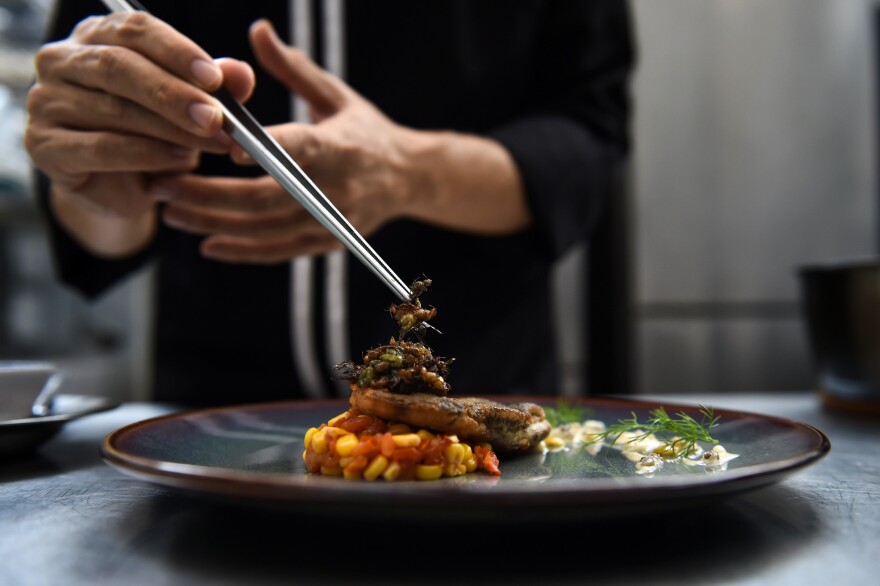In his tiny kitchen, chef Thitiwat Tantragarn throws a handful of raw bamboo caterpillars into a hot skillet and sautés them with olive oil, paprika, cumin, salt and pepper. Seconds later, the cream-colored larvae are crispy on the outside and soft on the inside. Tantragarn adds white wine, then spoons the bugs, brown beady eyes and all, over grilled scallops and Jerusalem artichokes before sending the plate out to the dining room.
This is , a restaurant in Bangkok that is turning bugs into haute cuisine. It opened in the city's trendy market in July.
In Thailand, it's not hard to find ant eggs, crickets and bamboo worms at markets and restaurants if you know where to look. But Insects in the Backyard is the only fine dining establishment in Thailand where the entire menu is devoted to bugs. The worms, crickets, grasshoppers, beetles and caterpillars here are paired with less intimidating grains, seafood and vegetables, "so it's not too scary for people who want to try our food," says Tantragarn.
Tantragarn, 30, didn't grow up eating insects in his native Bangkok. He trained in Thai and American kitchens, learning to make high-end Italian, French and New American cuisine. But Tantragarn switched gears because the world is now, as he puts it, in crisis: "The human population is growing but we don't have enough protein. So we need to find a source of protein that can sustain humans."

A 2013 report from the United Nations revealed that although the interest in edible insects is in its infancy, bugs can be part of the solution to feeding the world's 9 billion people by 2050.
In the U.S., insect farmers like Wendy Lu McGill, the founder and CEO of in Colorado, say the demand for edible bugs is slowly gaining ground. "In Denver, I work with five restaurants that offer edible insects, mostly crickets but increasingly other types as well. And chefs from all over the country regularly reach out for sourcing whole, non-roasted insects," McGill says.
But Mark Hoddle, director of the University of California-Riverside Center for Invasive Species Research, doesn't believe upscale full-menu insect dining will catch on in the West.
"They basically find it repulsive. There's a reason for that and it comes down to where Western culture originated, which has a climate that couldn't be more different from a tropical climate. They had temperate European-type climates. They didn't have temperatures that were available for year-round harvesting of insects," Hoddle says. "In Southeast Asia however, there are a lot of big bugs and they are basically available year-round. They were a resource available somewhat freely, easy to get, nutritious, and they didn't require huge inputs."
Of the thousands of known insect species in the world, at least 1,900 are edible, and Tantragarn is on a mission to work as many as possible onto his menu. Before the restaurant opened, he traveled around Thailand to visit farms growing and harvesting insects sustainably, under traceable, hygienic conditions. Tantragarn tasted countless bugs on his journey, then spent six months trying his favorites in different recipes. He eats insects whenever possible instead of pork, beef and chicken because they have a tiny carbon footprint, convert feed efficiently, are nutritious and don't require much land or water to cultivate.
Insects in the Backyard's nachos with deep-fried grasshoppers, white and red crickets and silkworms are Tantragarn's favorite creation. "That's because you can taste the bugs." Since the plate arrives at the table with the insect wings and legs intact and antennae twisting in strange directions, it's not for the faint of heart. But where else can you eat crunchy bugs on nachos sprinkled with the Egyptian spice blend dukkah and grated cheese?
Even the dining room has insect-themed decor. A giant sculptural Venus flytrap descends from the ceiling and pretty collections of pinned-up butterflies and moths hang on the walls. Floor-to-ceiling windows look out on lush tropical plants, causing you to forget for a minute you're in a city of 8 million people that never sleeps.

Tantragarn says his restaurant attracts more tourists than locals, perhaps because of their willingness to try "adventurous" foods. Today, a group of Thai-speaking diners giggles and takes photos of reactions to the silkworm tiramisu. The dessert is made by mixing ground silkworms with mascarpone cheese, whipping cream and sugar. Three toasted brown worms sit on top of the dish. They taste like hazelnuts and add texture to the rich creamy dessert.
The chef also teaches workshops on how to make insects edible at home. Last month, Bangkok resident Mishari Muqbil learned to extract the meat from giant water beetles to fill ravioli. "I took the class because I've read a fair bit about insects and how they are going to be the future of food due to the fact that they use up very little resources. I will definitely eat insects in the future," says Muqbil.
With a new set of gourmet edible insect dishes coming to the menu soon, Tantragarn wants to keep attracting intrepid eaters. The cost of running an edible insect fine-dining establishment can add up, especially when the kitchen goes through 22 pounds of bugs each week. Some bugs, like bamboo caterpillars, run about $15 a pound, making it much more expensive than chicken or pork. To bring down the price, insect farms will have to get much larger and consumer demand for bugs will have to grow.
Hoddle agrees that the cost of insects won't go down until commercial insect farms scale up, consumer demand for insects grows dramatically and there's more efficient insect rearing.
But Tantragarn is hopeful: "We may not make much money at this restaurant. But we're starting something. If humans around the world start eating more insects, then maybe our world can last a little longer."
Abbie Fentress Swanson is a journalist based in Los Angeles. She covers agriculture, food production, science, health and the environment.
Copyright 2021 NPR. To see more, visit https://www.npr.org. 9(MDA1NTMzNDA4MDEyNzk4MTU2OTg2ZjAyZQ004))



